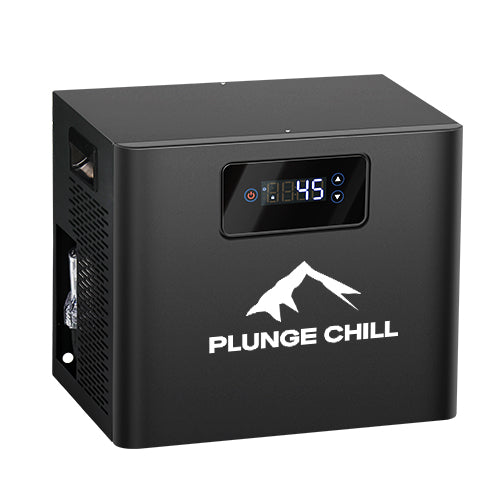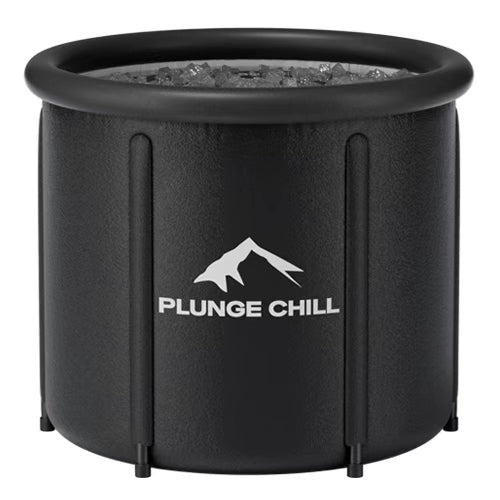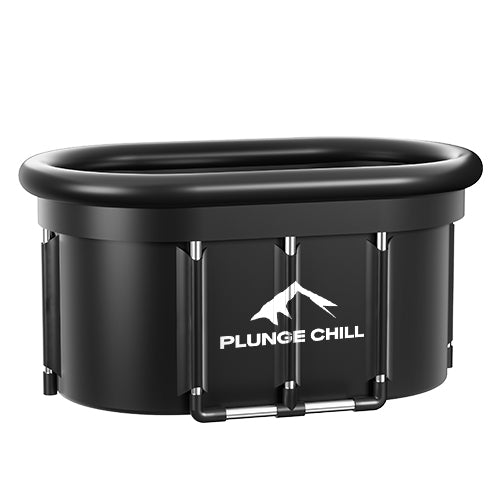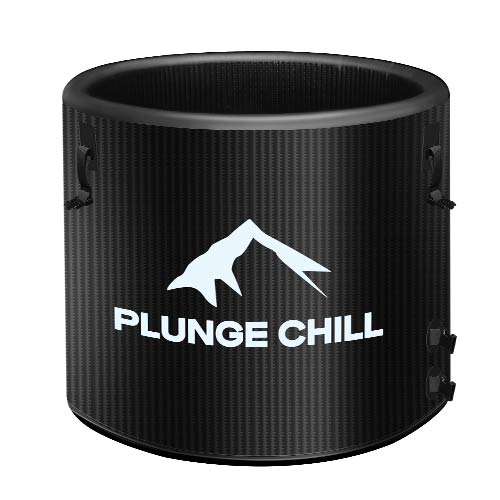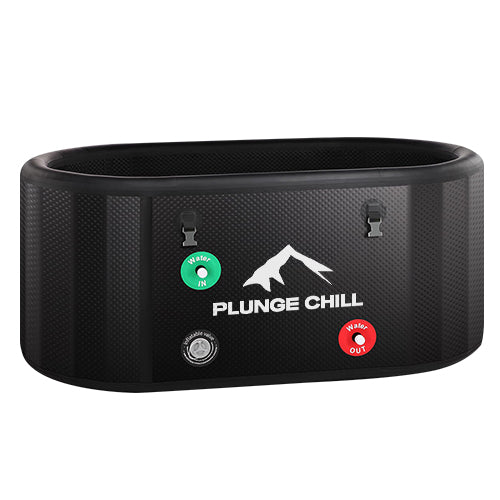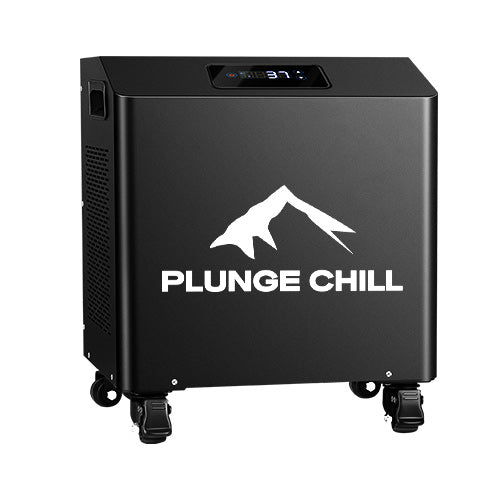Mark got out of the 35°F water feeling incredible. He was buzzing with energy, his mind was clear, and he felt like he could take on the world. He quickly dried off, got dressed, and even snapped a photo to show his friends he’d done it. He thought the hard part was over.
But about 15 minutes later, that great feeling started to fade.
It began with a small shiver, but that grew into a powerful, uncontrollable shaking. He started to feel dizzy. Instead of warming up, he was getting colder. His friends saw his lips turning a bit blue and noticed he was having trouble talking clearly.
Mark was experiencing "Afterdrop" and it's one of the most overlooked dangers in cold plunge therapy.

What is Afterdrop? (Why You Feel Colder After Getting Out)
Afterdrop is when your body's core temperature keeps dropping after you've left the cold water. It usually happens about 10 to 30 minutes later and while it's expected, it's something you need to manage carefully. Here’s the simple reason it happens:
Cold blood from your limbs returns to your core.
While you're in the icy water, your body does something clever: it pulls warm blood away from your skin, arms, and legs to keep your vital organs in your chest and abdomen warm. It's like your body is protecting its most important parts.
When you get out, everything opens back up. The colder blood from your arms and legs flows back to your center, mixing with your warm core and bringing your overall temperature down.
The chill is still working its way inward.
The cold doesn't just stay on your skin; it soaks deep into your muscles and tissues. Even after you’re dry, that deep chill continues to spread inward, cooling your core from the inside out.
For a little while, your body temperature will dip before your internal heating systems can kick in and bring it back up. Knowing how to handle this dip is everything.
Don't Jump in a Hot Shower Right Away
When you're chilled to the bone, your first thought is probably to get into a steaming hot shower. Resist that urge. Blasting your cold body with intense heat can be a shock to your system and can actually be dangerous.
Forcing your skin to heat up too fast causes the blood vessels there to fly open. This can lead to:
- Dizziness and Fainting: Blood rushes to your skin and away from your brain, causing a sudden drop in blood pressure. This can make you feel lightheaded or even pass out.
- Major Stress on Your Heart: Your heart has to work double-time to pump blood to both your cold core and your suddenly hot skin.
- "Rewarming Shock": Rewarming shock is a serious condition where your blood pressure drops to an unsafe level.
Think of it this way: gentle warming helps your body, while shocking it with heat works against it.
The Safe Warm-Up Plan: 3 Easy Steps
The goal is to warm up slowly from the inside out. Help your body generate its own heat instead of relying on outside sources.
Step 1: Get Dry & Layer Up Immediately (First 90 Seconds)
Your first mission is to stop losing heat.
- Get Out Calmly: No need to rush. A slow, steady exit is safer.
- Dry Off Completely: Water on your skin cools you down as it evaporates. Pat yourself dry instead of rubbing, as your skin might be sensitive.
- Stand on Something Dry: Get off the cold ground. Stand on a towel, a mat, or your shoes to stop heat from escaping through your feet.
- Put on Warm, Dry Clothes: This is critical. Have your clothes laid out and ready to go before you get in.
Your Post-Plunge Outfit
| What to Wear | Why It's a Good Choice |
| Wool or Fleece | These materials are great at holding in heat, even if you're a little damp. |
| A Warm Hat, Thick Socks, & Gloves | You lose a lot of heat from your head, hands, and feet. Cover them first! |
| A Windbreaker or a Big Blanket | This creates a shield to block any cold air from getting to you. |
| What to Avoid | Why It's a Bad Idea |
| Cotton (T-shirts, sweats) | Cotton soaks up water and holds it against your skin, making you colder. |
| Tight Clothes | You want your blood to circulate easily. Tight clothes can restrict it. |
Step 2: Create Your Own Heat with Gentle Movement (Minutes 2-15)
Now it’s time to fire up your internal furnace. Use your big muscles to slowly build warmth.
Spend 5 to 15 minutes doing easy, controlled movements.
- Walk Around: A slow and steady pace indoors works perfectly.
- Slow Squats: This gets your large leg muscles working to produce heat.
- Arm Swings: Gently swing your arms back and forth or in circles to encourage blood flow.
What not to do: Don't do a hard workout. Intense exercise can move cold blood around too fast and make the afterdrop feel worse. If you feel dizzy, just stop and focus on staying warm in your clothes.
Step 3: Warm Up from Within (Minutes 15-30+)
After you're dressed and have moved a bit, a warm drink or a small snack can help the warming process along.

What to Drink: Sip on something warm, not scalding hot.
- Herbal Tea: Ginger tea is a great choice to help boost circulation.
- Warm Broth: It's hydrating and gives you a bit of protein and salt.
- Warm Water with Lemon: Simple, but very effective.
What to avoid for now:
- Coffee: Caffeine can interfere with your body's natural warming process. Research shows that coffee intake may promote sweating and take away more heat because of its caffeine content. This works against you when you're trying to raise your body temperature.
- Alcohol: It tricks you into feeling warm but actually makes you lose body heat faster.
A small, warm snack like a bowl of oatmeal or soup can also give your body the fuel it needs to generate heat.

Are You Ready for a Hot Shower or Sauna?
Going from cold to hot is a popular technique, but timing is key.
Hot Showers: Wait at least 15 minutes after your plunge. Before you get in, check how you feel. If you're still shaking a lot or feel dizzy, it's not time yet. When you feel stable:
- Start the water lukewarm.
- Aim the water at your chest and back first.
- Slowly turn up the heat to a comfortable warm, never hot.
- Keep it short—just 5 to 10 minutes.
Saunas: A sauna is even more strong, and can be dangerous for non-professionals, especially older adults, pregnant women, or anyone with heart or lung conditions. If you're experienced and healthy, wait at least 20-30 minutes. Make sure you've stopped shivering and your head feels clear. Always drink some water before you go in and keep your first session short.
5 Key Mistakes to Absolutely Avoid
To keep your recovery safe and smooth, never do the following in the first 15-20 minutes:
- ❌ Don't use intense heat. No immediate hot showers, saunas, hot tubs, or electric blankets.
- ❌ Don't drink alcohol or coffee. Alcohol makes you lose heat faster, and caffeine can interfere with your body's warming process.
- ❌ Don't do hard exercise. Intense activity can make afterdrop worse. Stick to gentle movement.
- ❌ Don't stay in your wet clothes. Get them off immediately.
- ❌ Don't rub your skin hard. Numb, cold skin can be damaged easily. Pat yourself dry instead.
What to Do for Severe Afterdrop: An Emergency Plan
If your symptoms feel intense (violent shaking, dizziness, confusion), stop the normal routine and take these emergency steps:
- Stop all movement. Immediately sit or lie down in a sheltered spot. Don't try to "walk it off."
- Get insulated. Make sure you are completely dry. Wrap yourself in a thick, dry blanket or a sleeping bag. If someone is with you, huddle together for shared body heat.
- Sip a warm, sweet drink. If you can, slowly drink something warm and sugary (like warm water with honey or a non-caffeinated sports drink). This provides your body with fuel to shiver and create heat.
- Do NOT use intense heat. Do not take a hot shower or use a heating pad. This can make the situation much worse.
- Know when to call for help. If you are confused, your speech is slurred, or the shaking is so bad you can't function, you are moving toward hypothermia. Have someone call for medical help immediately.

Your Body, Your Rules
These are just general guidelines. Everyone is different. If you're new to cold plunges, you'll warm up more slowly than someone who does them every day. Listen to what your body is telling you—it knows best.
Quick Questions
Q1: How long does afterdrop last?
Usually, it’s over in 15-30 minutes if you follow these steps. If you had a really cold plunge, it might take closer to an hour. If you’re still shaking badly after an hour or start to feel confused, it's best to get medical help.
Q2: Is shivering okay?
Yes! Shivering is your body's best tool for making heat. It's a good sign. It only becomes a concern if it's so intense you can't control it or if you also feel disoriented.
Q3: What should I tell a friend to look for if they're watching me?
Tell them to watch for the "umbles": stumbling, mumbling, or fumbling. If you have trouble walking, talking clearly, or using your hands, it’s a sign you're getting too cold. That's their cue to help you get out and get warm immediately.
Q4: How do I know if I have afterdrop?
Look for these signs 15-20 minutes after your plunge: a continued cold feeling, uncontrollable shaking, dizziness, nausea, heart palpitations, fuzzy thinking, muscle weakness, or poor coordination. If these are happening, it's likely afterdrop.
Q5: Do I need ice for cold plunges at home?
Not necessarily! Modern chillers like Plunge Chill's cold plunge chiller can cool water down to 39°F without any ice, making home cold therapy much more convenient and cost-effective than buying ice daily.
Q6: How can I avoid dangerous temperature shock at home?
Consistency is key for safety. Unlike ice baths that warm up quickly, a reliable chiller keeps steady temperatures throughout your session. Devices like the Plunge Chill Chiller maintain water at exactly the temperature you set, preventing dangerous temperature changes that can worsen afterdrop or cause shock.
